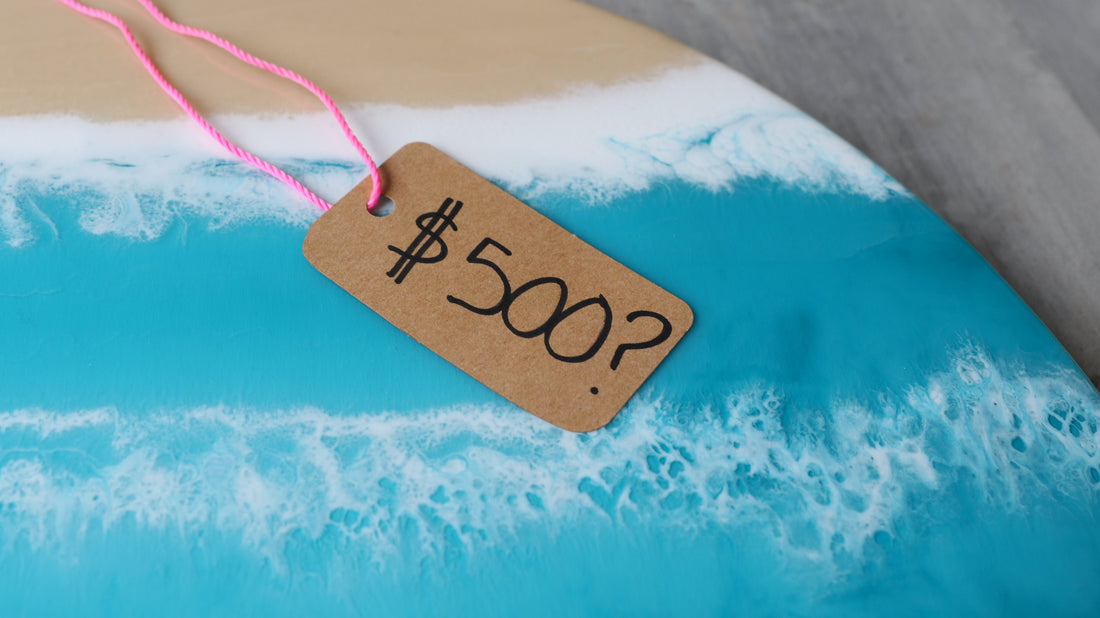As artists, we all want to make sales, but finding that perfect price point can feel stressful. There's no right or wrong way to price your art - unless you’re not selling, of course, in which case you need to make some adjustments!
Fortunately, there are a few key factors that can help you confidently put a number on your art and make the process a bit easier!
Art Pricing Basics: Understanding Your Costs
Before setting a price for your resin artwork, it's important to consider all of the involved costs. At a bare minimum, your price should cover your materials, overhead, and your time. What’s your time worth? $20/hr? $50/hr? Or are you just happy to make a sale?
Costs can be broken down into two main categories: direct and indirect expenses.
1. Direct Material Costs
These are the essential supplies needed to create your resin pieces. They include things like:
- Resin and hardener
- Colorants, pigments, and additives
- Base materials (wood, canvas, etc.)
- Tools such as mixing cups, stir sticks, worksurface liners, heat gun, torch
- Protective gear (gloves, masks, etc.)
It’s helpful to keep track of these costs as larger pieces that use more resin should be priced higher to reflect that.
2. Indirect Expenses
Indirect expenses are those that aren't always obvious but are essential for your business operations, such as:
- Studio space rental
- Utilities and maintenance costs
- Marketing and promotional activities
- Shipping and handling fees
Including these in your pricing strategy ensures you're covering all the bases and not just the materials!
Establishing Your Pricing
Now that you’ve got a handle on your costs, it’s time to figure out how to price your resin art. Here are a few methods to help guide you:
1. Cost-Plus Pricing
This is one of the simplest ways to price your work. You take your total costs and add a markup. For example, if a piece costs you $50 to make and you want to add a 50% markup, the calculation would look like this:
Selling Price = Total Costs + (Total Costs x Markup Percentage)
So, in this case:
Selling Price = $50 + ($50 x 0.50) = $75
2. Market Analysis
It’s really helpful to do some research on what similar pieces are selling for. Check out Etsy or visit local art fairs to get a feel for the market. This will help you find a sweet spot where your prices are competitive, yet still reflect the value of your work.
3. Valuing Your Time and Expertise
Don’t forget to factor in your time and skills! Think about how many hours you spend on each piece and set an hourly rate for yourself. For instance, if you spend 5 hours on a piece and value your time at $20 per hour, you’d add $100 to your costs.

The 5 W's Of Pricing
Now let's move on to the what, who, where, when and why?
WHAT are you selling?
Certain mediums fetch more money. Historically, drawings were used to make studies which were then turned into larger masterpieces. Typically these were done in oil paint. Oil paintings, therefore, fetch the most.

Bigger generally fetches more. Some people actually make a square foot calculation when pricing their art. Also remember that providing a range of sizes will appeal to various budgets which in turn improves your chances for a sale.

Supply and demand affects value. Originals will always fetch the most. If you’re doing reproductions, make a limited edition to up the value of each print. That said, sometimes you can make more in the long run by selling a large number of less expensive reproductions.
WHO are you selling?
You’re selling yourself as the artist when you sell your work. Tell a compelling narrative about yourself in your artist bio to help people get to know you.

If you’re an experienced artist who has won any awards or have received positive media attention, that should all help boost your prices.
Price high and justify!
WHERE are you selling?
Urban centers fetch more.

Do some research and look at the local galleries. Those prices are reflective of what the market is willing to pay. It may be worth the travel expense to exhibit downtown over an area outside of the city.
WHEN are you selling?
Certain times of the year may be better to release your work at a higher price tag, such as around the holidays when everyone is in a buying mode.

If you have pieces that have sat around for some time and you want to clear your inventory, invite your past clients to an exclusive event with discounted works of art—this way you honor their patronage and at the same time aren't devaluing the art that they paid full price for.
WHY are you selling?
There are other options besides selling! You could simply rent your art through galleries or even film and TV shows who typically take 20% off the top of your cost for the artwork.

Ultimately buyers and sellers value artwork both emotionally and intellectually. For example, you may see something that reminds you of your childhood and therefore that connection may drive you to make a purchase. The person standing right beside you doesn't have that same connection and walks away. Personal values always play a role.

For a lot of people, framing is a barrier to purchase. This frame costs around 50% of the price of the art itself. You could frame your art to get it to sell, but generally this is a waste as framing is a matter of taste. Instead, ArtResin it! Artists can consistently charge more for art coated in ArtResin, and it tends to sell faster because it appears more polished and professional.

Effective Sales Strategies for Resin Art
Once you’ve nailed down your costs and set a base price, here are some strategies to help boost your sales:
1. Highlight Unique Features
Showcase what makes your resin art stand out—whether it’s custom designs, striking color combinations, or premium materials. Highlighting these unique aspects can help justify a higher price and attract buyers looking for something special.
2. Create Bundles
Offer bundle deals, like sets of coasters or wall art groupings, at a slightly discounted rate. This not only encourages customers to buy more but also helps increase your overall sales.
3. Seasonal Promotions
Take advantage of holidays and special occasions by offering themed resin pieces at promotional prices to attract buyers. This can be a great way to drive more sales during key times of the year.
Key Considerations for Pricing Resin Art
When setting prices for your resin creations, here are a few important things to keep in mind:
1. Market Demand
Knowing what’s in demand in your market is key. If resin art is highly sought after, you can price higher. If demand is lower, you might need to adjust accordingly. Engaging with your audience on social media or conducting simple surveys can give you a sense of what people are looking for.
2. Artist Reputation
Your reputation matters. Established artists with a solid following can charge more because of the perceived value. Building your brand, sharing your work, and connecting with buyers over time can help boost your reputation and justify higher prices.
3. Quality of Materials
Don’t forget, the quality of your materials plays a big role in pricing. If you’re using premium resin, pigments, or unique mixed mediums, your pieces will stand out and deserve higher price tags. Be sure to communicate the quality to your buyers so they understand the value they’re getting.
In the end, sell your art for a price that you will be happy with. It's your baby. Be proud and never sell yourself short!
How do you price your art? Let us know in the comments!
Get more business tips in our blogs:
-
Learn How To Turn Your Resin Crafts Into Sales
- How to Make Money as an Artist
- FREE e-book: Guide To Selling Your Resin Work
- How Can I Increase The Value Of My Artwork?
ArtResin: The Original Epoxy For Resin Art.

